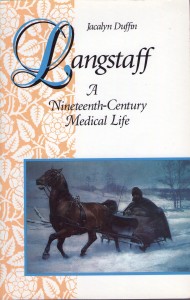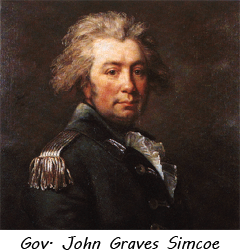Dr James Miles Langstaff

For forty years, James Langstaff practiced medicine in the rural community of Richmond Hill, a few miles north of what is now Toronto.
Much of the information on the Langstaffs in Upper Canada has been gleaned from a book written and compiled by Jacalyn Duffin titled: “Langstaff, A Nineteenth-Century Medical Life”.
According to Duffin:
“His (Dr. James Langstaff’s) importance lies in the precious legacy of a nearly complete set of his medical daybooks and accounts. Written in beautiful script and solidly bound, these volumes chronicle the daily practice of an ordinary doctor and probably represent the most complete, most legible and longest-running set of nineteeth-century medical daybooks in Ontario, if not all of Canada. They reveal that this doctor rarely took a day off, less often left his region, and never attended a medical conference, yet he adopted the innovations of his era.”
“James Langstaff was a third-generation Canadian on his mother’s side. He grew up on the family farm, fifteen miles north of Toronto, on Yonge Street, the longest and oldest street in Upper Canada. The road, the land and the family had always defined and secured his place in the world. Here he was born and here, at the age of sixty-four and less than three miles away, he would die.
The district extended just over thirty miles from the Lake Ontario harbour of Toronto (called York until 1834) to the southern shore of Lake Simcoe. Deeply furrowed by tributaries of the Don and Humber rivers, the land rose slowly to a ridge covered with oaks twenty miles north of the city. A generation before the birth of James Langstaff, this territory had been densely forested with ash, maple, elm, black walnut, basswood, and white pine “so deep that the sun’s rays rarely reached the forest floor”.
Dr. James Langstaff was married to Mary Anne Miller. Mary Anne’s grandfather was Nicholas Miller (1760-1810), the first Caucasian settler to the region, and builder of the King’s Mill on Humber River, (now a restaurant in suburban Toronto). Nicholas Miller was born July 25, 1760 in Somerset City, Pennsylvania. His efforts to erect a log home on his Yonge Street clearing in the fall of 1793 are said to have received unexpected assistance from the troops of Governor John Graves Simcoe. Other settlers soon followed. In 1794, industrious Pennsylvania-German people arrived under the leadership of artist and entrepreneur William Berczy, and in 1798, the Compte de Puissaye brought a handful of ’emigre’ French aristocrats seeking refuge from the Revolutionary Terror. The latter group abandoned pioneer life after only two years but the former stayed and, by the 1830’s, had partially cleared the land. The farms of these tenacious settlers grew in prosperity because of their proximity to markets and government. There were still occasional stands of valuable white pine in the north; as the arable spaces became occupied, sawmills were built at frequent intervals along the many streams.
The Langstaff farm was situated one lot north of the Miller homestead and had been a Crown grant to James Langstaff’s maternal grandfather, Abner Miles (1752-1806). James Langstaff’s mother was Abner Mile’s daughter, Lucy Miles. Lucy’s bachelor brother James had taken over their father’s business in Richmond Hill, and in having no children of his own, became a patron of the community families, who called him ‘Squire Miles’. In 1811, he founded a Sunday School in a simple log building, with an earthen floor and split log benches, that served as a place of worship and education. Six years later, Squire Miles brought the feisty, Scottish-born Reverend William Jenkins from his missions to the Oneida in New York State, to the growing Presbyterian flock on Yonge Street. In 1821, through the combined efforts of Miles and Jenkins, a frame church was completed at the site of the Sunday school, on land purchased from Elizabeth (Miles) Playter. Presbyterianism and pedagogy were linked commitments for the Miles descendants, and this same church would become one of the doctor’s charities.
James’s father, John Langstaff, had come to the region on horseback from Amboy, New Jersey, sometime between 1803 and 1808. He was a fifth-generation American and one of nine children whose ancestors had left south-central England to settle in New Hampshire in the seventeenth century. Legend has it that John Langstaff went back to New Jersey but returned the following year for love of Mercy Miles, who married him at the relatively late age of twenty-five. After her father’s death, the couple acquired the Yonge Street farm where they raised eight children. Four boys and four girls. James Miles Langstaff the youngest was born on 3 June, 1825. both his given names followed the stamp of family tradition: ‘Miles’ for his mother, uncle, grandfather and older brother; ‘James’ for both maternal and paternal uncles and his paternal grandfather, who had also been James Langstaff.
John Langstaff shared his brother-in-law’s interest in education and had taught in a log schoolhouse erected on the Munshaw property next to his own farm. Local schools commemorate him as the region’s first teacher, but he left teaching to serve in the York Militia during the War of 1812. His reasons for fighting against his native country are not clear, but many other American immigrants took part in this war. Enlisting in the British Militia may have helped establish patriotic credibility. After the war he supplemented farming with running a store, a smithy, and factories for the manufacture of pails, shingles and eaves troughs.”
